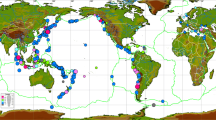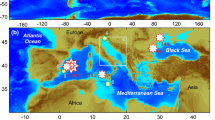Abstract
The run-up catalogs of two global tsunami databases maintained by the NCEI/WDC NOAA and NTL/ICMMG SD RAS are examined to compile the list of annual maximum runups observed or measured in the oceanic, marine and inland basins during the last 120 years (from 1900 to 2019). All the retrieved annual maximum runups were divided into four groups according to four main types of tsunami sources (seismogenic, landslide-generated, volcanic, and meteorological). Their distribution over the type of sources shows that of the 120 maximum runups only 78 (65%) resulted from seismogenic sources, while the remaining 42 runups were divided between landslide-generated (19%), volcanic (8%), and meteorological (7.5%) sources. The analysis of geographical distribution of source locations demonstrates that tsunamis are not exclusively a marine hazard—over 15% of all maximum runups were observed in coastal and inland water basins (narrow bays, fiords, lakes, and rivers). Temporal distribution of the collected runups shows that annual occurrence of large tsunamis was more or less stable throughout the twentieth century and only demonstrates some increase during the last 27 years (since 1992) when the practice of post-event surveys of all damaging tsunamis was implemented. This paper also outlines the existing problems with data compilation, cataloguing, and distribution, and discusses incompleteness of runup and wave-form data for a considerable number of non-damaging tsunamis, even those resulting from the strong (magnitude higher than 7.5) submarine earthquakes.


Similar content being viewed by others
References
Arcos, N., Dunbar, P., Stroker, K., & Kong, L. (2019). The impact of post-tsunami surveys on the NCEI/WDS Global Historical Tsunami Database. Pure and Applied Geophysics,176, 2809–2829. https://doi.org/10.1007/s00024-019-02191-7.
Gusiakov, V. K. (2009). Tsunami history: Recorded, In: Eds. E.N. Bernard and A.R. Robinson, The Sea, (Vol.15, pp. 23–53), Cambridge, MA, USA: Harvard University Press.
Gusiakov, V. K. (2011). Relationship of tsunami intensity to source earthquake magnitude as retrieved from historical data. Pure and Applied Geophysics, 168(11), 2033–2041. https://doi.org/10.1007/s00024-011-0286-2.
Gusiakov, V. K. (2014) Tsunami impact on the African coast: Historical cases and hazard assessment. In: Eds. A. Ismail-Zadeh, J.C. Fucugauchi, A. Kijko, K. Takeuchi, and I. Zaliapin, Extreme Natural Hazards, Disaster Risks and Societal Implications, Cambridge University Press, pp. 225- 233. 10.1017/CBO9781139523905.021.
Gusiakov, V. K., Dunbar, P., & Arcos, N. (2019). Twenty ive years (1992–2016) of global tsunamis: statistical and analytical overview. Pure and Applied Geophysics,176, 2795–2807. https://doi.org/10.1007/s00024-019-02113-7.
Lander, J. F. (1996). Tsunamis affecting Alaska, 1737–1996 (p. 195). Colorado, National Geophysical Data Center: Boulder.
Miller, D.J. (1960) Giant waves in Lituya Bay, Alaska. Geological Survey Professional Paper 354-C, U.S. Government Printing Office, Washington, p.50–85.
NCEI/WDS. (2020). Global Historical Tsunami Database, 2100 BC to Present, 10.7289/V5PN93H7, Accessed 30.11.2018.
NTL/ICMMG SD RAS. (2020). Novosibirsk Tsunami Laboratory of the Institute of Computational Mathematics and Mathematical Geophysics of Siberian Division of Russian Academy of Sciences) Global Tsunami Database, 2100 BC to Present, Available at: https://tsun.sscc.ru/nh/tsunami.php, Accessed 15.12.2018.
Okal, E. (2019). Twenty-five years of progress in the science of “geological” tsunamis following the 1992 Nicaragua and Flores events. Pure and Applied Geophysics,176, 2771–2793. https://doi.org/10.1007/s00024-019-02244-x.
PDM/TSU (Parametric Data Manager for Tsunami data management) graphic shell. (2020). NTL/ICMMG SD RAS, https://tsun.sscc.ru/PDM.htm, Accessed 15.01.2020.
Rabinovich A. (2020) Twenty-seven years of progress in the science of meteorological tsunamis following the 1992 Daytona Beach event, Pure and Applied Geophysics, 177, (this issue) https://doi.org/10.1007/s00024-019-02349-3
Rabinovich, A. B., & Eblé, M. C. (2015). Deep-ocean measurements of tsunami waves. Pure and Applied Geophysics,172, 3281–3312. https://doi.org/10.1007/s00024-015-1058-1.
Shuto, N. (1983). The Nihonkai Chubu earthquake tsunami. Tsunami Newsletter, XVI(2), 31–40.
Soloviev, S.L., & Go, Ch.N. (1975). A Catalog of Tsunamis on the Eastern Shore of the Pacific Ocean, USSR Academy of Sciences, Nauka Publishing House, Moscow, 204 p. Translated from Russian to English by Canadian Institute for Science and Technical Information, No. 5078, National Research Council, Ottawa, Canada, 293 pp, 1984.
Acknowledgements
Figures in this paper were drawn using built-in options of the PDM/TSU graphic shell (PDM/TSU 2020) developed in the NTL/ICMMG SD RAS as supporting software for the tsunami database. The author wishes to thank Emile Okal and Fred Stephenson for careful reading of the manuscript and making numerous suggestions for its improvement as well as Tamara Kalashnikova and Katia Lyskovskaya for assistance in data processing and figure drawing. The results presented in this paper were supported by the RAS Project no. 0315-2019-0005.
Author information
Authors and Affiliations
Corresponding author
Additional information
Publisher's Note
Springer Nature remains neutral with regard to jurisdictional claims in published maps and institutional affiliations.
Rights and permissions
About this article
Cite this article
Gusiakov, V.K. Global Occurrence of Large Tsunamis and Tsunami-like Waves Within the Last 120 years (1900–2019). Pure Appl. Geophys. 177, 1261–1266 (2020). https://doi.org/10.1007/s00024-020-02437-9
Received:
Revised:
Accepted:
Published:
Issue Date:
DOI: https://doi.org/10.1007/s00024-020-02437-9




